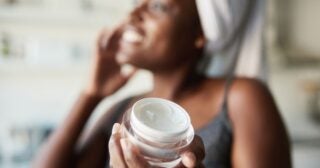- Resources
- Three reasons 2023 is the year for companies to center #CleanBeautyJustice
Resources
Three reasons 2023 is the year for companies to center #CleanBeautyJustice
Published: February 7, 2023 by EDF Staff
1. A new law paves the way for policy advancements and there’s more work to be done
For over 80 years, the cosmetic industry has been deeply underregulated. FDA has historically depended on voluntary compliance and guidance, even for product recalls. Late last year, Congress passed the Modernization of Cosmetics Regulation Act of 2022, the first major update to the Food, Drug & Cosmetics Act since 1938, and a step towards addressing long needed reforms to the law.
The Bill provides the FDA with stronger tools to monitor, regulate, and enforce against misbranded, adulterated, or otherwise non-compliant cosmetic and personal care products. This means that cosmetic companies will soon be subject to new requirements for registration and product listing, adverse event reporting, and disclosure of ingredients, including ingredient labeling for professional salon products, among other regulations. At the same time, there is much work to be done. While the passage of the bill breaks the historical impasse on the regulations of the industry, more work is needed to put policies in place that further protect communities of color – who face greater risk to exposure of hazardous chemicals in beauty and personal care products.
2. Scientific evidence mounts
This past year saw a wave of new research demonstrating Black women’s disproportionate exposure to hazardous chemicals in beauty and personal care products.
New research provides additional evidence that these exposures are also linked to health disparities. Last year, researchers published an NIH study that found that the use of chemical straighteners is linked to a higher incidence of uterine cancer. Additionally, new research from Columbia University, in partnership with WeACT for Environmental Justice, points to the impact of racialized beauty norms on consumer use of products that often contain hazardous chemicals, like chemical straighteners and skin lighteners.
In January of this year, Washington State Department of Ecology (DEP) published a new study identifying cosmetic and personal care products marketed to or used by people of color, including children, and evaluating those products for the presence of hazardous chemicals. The researchers found formaldehyde in 26 out of 30 body lotions and hair products and found lead and arsenic in several make-up products. This research is part of an effort by lawmakers in the state to pass a bill banning certain chemicals in cosmetic products.
These issues are compounded by the fact that access to safer products can depend on where you live and shop. And while these new studies have yielded alarming results, they are key to understanding the inequitable effects of beauty products and catalyzing action for clean beauty justice.
3. Companies are beginning to act
Corporate action is one piece of the solution to ending this toxic reality.
2022 saw more retailers and their suppliers set policies to address hazardous chemicals in beauty and personal care products. As part of their chemical policy, Sephora educated internal teams on beauty justice issues and evaluated their policy for chemicals of concern relevant to product marketed to people of color. Walmart announced it will open a new clean beauty shop with a robust list of hazardous chemicals that won’t be allowed in products, which will increase access and availability of safer products. We need to ensure that corporate action centers communities of color, who face disproportionate exposure.
